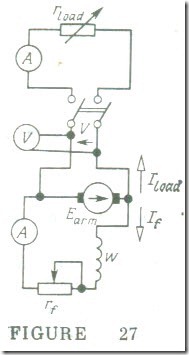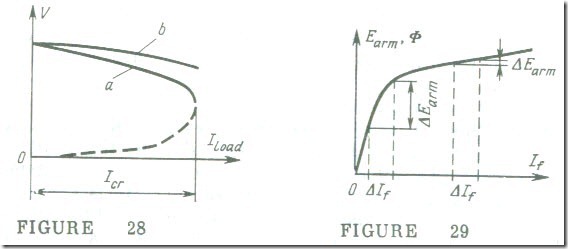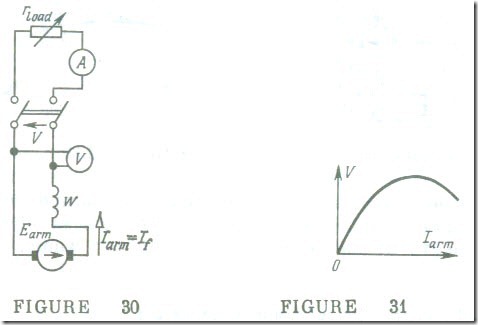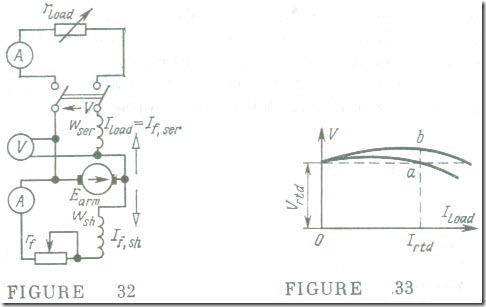Shunf, Series and Compound Generators
In a shunt generator, a fraction of the armature current serves to excite the main magnetic field of the machine (Fig. 27). Shunt generators are widely used as sources of direct current as they need no external source for excitation, which fact markedly simplifies their use. On the other hand, their terminal voltage varies but little with changes in loading.
The open-circuit characteristic of a shunt generator does not practically differ from that of a separately excited machine, because variations in rfIf and armature reaction due to the field current have but a negligible effect on the behaviour of a shunt generator. This statement is also true of the control characteristic.
In contrast, the external characteristic of a shunt generator (Fig. 28 a) runs far below than it does in the case of separate excitation (Fig. 28 b). This is due to the decrease in the field current with a decrease in the terminal voltage because If = V/rf. In the case-of separate excitation, the decrease in the terminal voltage with a rise in the armature current is due to two factors: the increase in the voltage drop across the armature resistance and armature reaction. In the case of shunt excitation, a third factor has to be added to the first two, namely the decrease in the field current. So long as the field current corresponds to the condition of saturation. of the magnetic circuit (the gradually sloping part of the magnetization curve), the decrease in the armature emf is smaller than the -decrease in the field current (Fig 29). In these conditions, a decrease in the load resistance is accompanied by a rise in the armature current. The conditions drastically change, however, when the increase in the armature current and the associated decrease in the terminal voltage result in such a reduction in the field current that l the magnetic circuit is no longer saturated. Now the linear portion of the magnetization curve applies, and the decrease in the field current brings about a proportionate decrease in the flux and armature emf. This brings about a further decrease in the field current which leads to a new decrease in the emf, and so on. In a way, the generator experiences self-demagnetization which ends in that, with the armature short-circuited, the machine only retains a residual magnetization sustaining a limited short-circuit current (which is smaller than the rated current).
The armature current at which a machine experiences self-demagnetization is called critical, I cr . It is 2 to 2.5 times the rated current. !he portion of the external characteristic below I cr (shown dashed In Fig. 28) corresponds to an unstable mode of operation.
The voltage regulation of shunt generators is markedly greater than that of separately excited machines, being equal to 8-15%.
In a series generator the armature winding is connected in series with the field winding, so the load current is at the same time the field current (Fig. 30). The field winding of a series generator is wound with a heavy-gauge wire to suit a heavy armature current, and with a small number of turns.
In the open-circuit condition the emf induced in the armature winding of a series generator is solely due to the residual flux. Therefore, we cannot plot an open-circuit characteristic for such a machine. Nor has it a control characteristic.
The voltage of a series generator (Fig. 31) initially rises with increasing armature current. Then the shape of the characteristic changes due to magnetic saturation (the armature emf ceases to build up, while the voltage drop across the armature resistance keeps rising) and to the demagnetizing effect of armature reaction. Therefore a further increase in load brings about a decrease in the terminal voltage of the generator. Because of an unstable terminal voltage, series generators are used only in a few special cases.
A compound generator has two field windings, one shunt wsh and the other series wser (Fig. 32). The terminal voltage of a compound generator remains practically constant as the load varies within certain limits. This is achieved through the use of series excitation in order to make up for the increase in the voltage drop across the armature resistance, the decrease in the current of the shunt field winding, and the demagnetizing effect of armature reaction when the load current goes up. Owing to the series field winding, the main magnetic flux and also the armature emf go up as the load is increased. By choosing the right number of turns in the series field winding, it is possible to secure the same voltage in the open circuit condition (at no load) and under the rated load (curve a in Fig. 33).
Compound generators are convenient to use in relatively small units as a means of preventing marked changes in voltage when some of the loads are disconnected. However they are not well adapted for parallel operation because even a chance drop in the speed of the prime mover may cause the generator emf to fall to a level below that of the line voltage so that the current in the armature find series field windings is reversed entailing a polarity reversal of the generator and a heavy damage to the installation as a whole.




